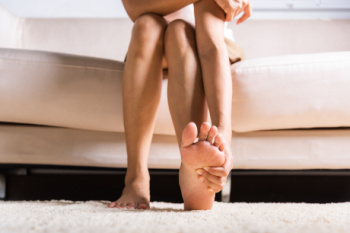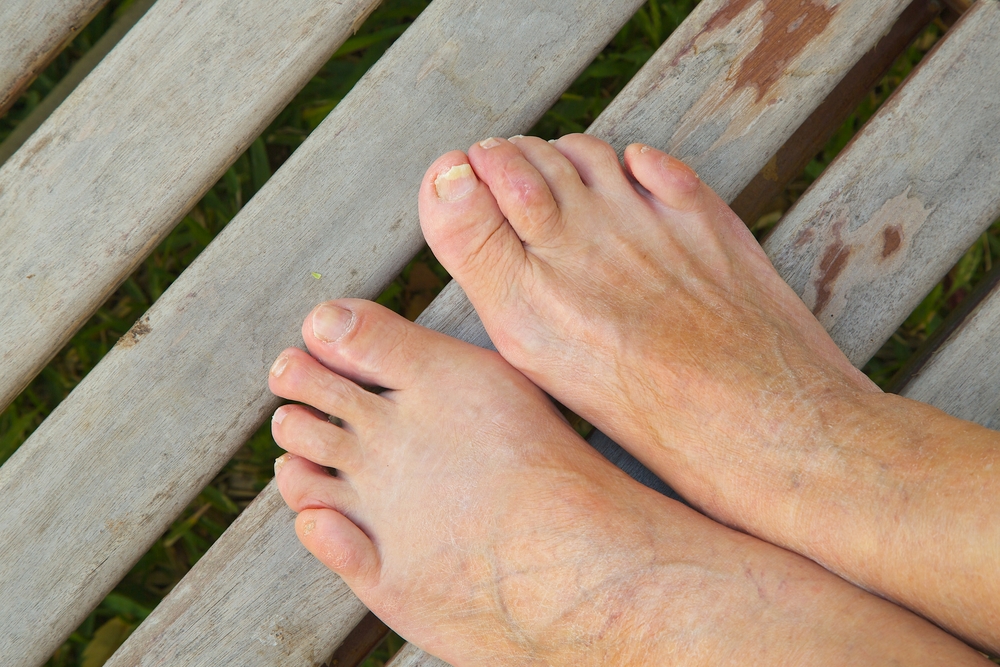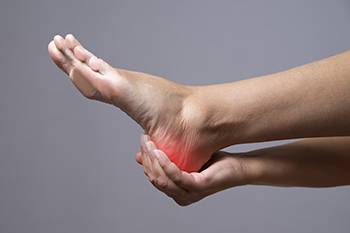Connect With Us
Blog
Items filtered by date: May 2024
Foot Injuries at Fitness Facilities

Foot injuries are a common occurrence in fitness facilities, often the result of crush injuries from free weights, falls, or awkward landings during exercise classes. These injuries can range from minor sprains to more severe fractures, impacting one's ability to maintain an active lifestyle. Prevention techniques play a critical role in reducing the risk of foot injuries. Properly warming up and stretching before exercise sessions can enhance flexibility and prevent strains. Wearing appropriate footwear with adequate support and cushioning is essential to absorb shock and protect the feet from impact. Additionally, maintaining good form and technique during exercises can help minimize the risk of falls and accidents. If you have sustained a foot injury while working out at a fitness center, it is suggested that you schedule an appointment with a podiatrist for an evaluation and treatment. This will help with a speedy recovery and encourage you to return safely to your fitness routine.
Ankle and foot injuries are common among athletes and in many sports. They can be caused by several problems and may be potentially serious. If you are feeling pain or think you were injured in a sporting event or when exercising, consult with Pedram Aslmand, DPM from Advanced Foot and Ankle Center. Our podiatrist will assess your condition and provide you with quality foot and ankle treatment.
Common Injuries
The most common injuries that occur in sporting activities include:
- Achilles Tendonitis
- Achilles Tendon Rupture
- Ankle Sprains
- Broken Foot
- Plantar Fasciitis
- Stress Fractures
- Turf Toe
Symptoms
Symptoms vary depending upon the injury and in some cases, there may be no symptoms at all. However, in most cases, some form of symptom is experienced. Pain, aching, burning, bruising, tenderness, tightness or stiffness, sensation loss, difficulty moving, and swelling are the most common symptoms.
Treatment
Just as symptoms vary depending upon the injury, so do treatment options. A common treatment method is known as the RICE method. This method involves rest, applying ice, compression and elevating the afflicted foot or ankle. If the injury appears to be more serious, surgery might be required, such as arthroscopic or reconstructive surgery. Lastly, rehabilitation or therapy might be needed to gain full functionality in the afflicted area. Any discomfort experienced by an athlete must be evaluated by a licensed, reputable medical professional.
If you have any questions, please feel free to contact our offices located in Long Beach, CA . We offer the newest diagnostic and treatment technologies for all your foot care needs.
How Systemic Diseases Can Affect Feet

There are a host of systemic diseases that can contribute to various foot problems, affecting mobility and quality of life. Sciatica, caused by compression of the sciatic nerve, can lead to radiating pain, numbness, and tingling sensations in the feet. Hypothyroidism, characterized by low thyroid hormone levels, may result in cold feet, swelling, and thickened skin. Embolic arterial occlusion, a sudden blockage of an artery by a traveling clot, can cause acute pain, discoloration, and decreased sensation in the feet. Treatment for these conditions varies, depending on the underlying cause and severity. Sciatica may require pain management or surgery in severe cases. Hypothyroidism typically involves hormone replacement therapy and lifestyle modifications. Treatment for embolic arterial occlusion can include blood thinners, thrombolytic therapy, or surgical intervention. If you are experiencing foot problems associated with a systemic disease, it is suggested that you schedule an appointment with a podiatrist for personalized care and treatment to improve foot function.
When dealing with systemic disease of the feet, it is extremely important to check the affected areas routinely so that any additional problems are caught quickly. If you have any concerns about your feet and ankles contact Pedram Aslmand, DPM from Advanced Foot and Ankle Center. Our podiatrist will assist you with all of your podiatric needs.
Systemic Diseases of the Feet
Systemic diseases affect the whole body, and symptoms usually are displayed in the feet. This condition can make a patient’s ability to walk unbearable. Systemic diseases include gout, diabetes mellitus, neurological disorders, and arthritis.
Gout – is caused by an excess of uric acid in the body. Common symptoms include pain, inflammation, and redness at the metatarsal/phalangeal joint of the base big toe. Gout can be treated by NSAIDs to relieve pain and inflammation, and other drugs that lower the acid levels in the body.
Diabetes mellitus – is an increase in the level of blood sugar that the body cannot counteract with its own insulin. Failure to produce enough insulin is a factor in Diabetes.
Diabetes of the Feet
Diabetic Neuropathy – may lead to damaged nerves and affect the feet through numbness and loss of sensation.
Peripheral Vascular Disease – can restrict the blood flow to the feet, and often times lead to amputation of the feet.
If you have any questions please feel free to contact our offices located in Long Beach, CA . We offer the newest diagnostic and treatment technologies for all your foot and ankle needs.
Hammertoe in Kids

Hammertoe, a condition where one or more toes bend abnormally at the middle joint, can affect children as well as adults. It typically occurs due to an imbalance in the toe muscles, often exacerbated by wearing ill-fitting shoes or genetic predisposition. Children with hammertoe may experience discomfort, corns, or calluses, especially when wearing shoes. Treatment options for hammertoe in kids vary depending on the severity of the condition. Non-invasive measures such as wearing roomier footwear, toe exercises, and custom orthotic inserts can provide relief. In more severe cases, surgical intervention may be necessary to correct toe alignment. If you have a child who appears to be developing a hammertoe, it is suggested that you schedule an appointment with a podiatrist who can assess the severity of the condition in addition to providing interventions and treatment that can help to alleviate discomfort, prevent progression, and ensure optimal foot health.
Hammertoes can be a painful condition to live with. For more information, contact Pedram Aslmand, DPM of Advanced Foot and Ankle Center. Our podiatrist will answer any of your foot- and ankle-related questions.
Hammertoe
Hammertoe is a foot deformity that occurs due to an imbalance in the muscles, tendons, or ligaments that normally hold the toe straight. It can be caused by the type of shoes you wear, your foot structure, trauma, and certain disease processes.
Symptoms
- Painful and/or difficult toe movement
- Swelling
- Joint stiffness
- Calluses/Corns
- Physical deformity
Risk Factors
- Age – The risk of hammertoe increases with age
- Sex – Women are more likely to have hammertoe compared to men
- Toe Length – You are more likely to develop hammertoe if your second toe is longer than your big toe
- Certain Diseases – Arthritis and diabetes may make you more likely to develop hammertoe
Treatment
If you have hammertoe, you should change into a more comfortable shoe that provides enough room for your toes. Exercises such as picking up marbles may strengthen and stretch your toe muscles. Nevertheless, it is important to seek assistance from a podiatrist in order to determine the severity of your hammertoe and see which treatment option will work best for you.
If you have any questions, please feel free to contact our offices located in Long Beach, CA . We offer the newest diagnostic and treatment technologies for all your foot care needs.
Possible Causes of Heel Pain

Heel pain can stem from various factors, including plantar fasciitis, Achilles tendonitis, heel bursitis, Haglund’s deformity, heel spurs, or even stress fractures. Symptoms often manifest as sharp or dull pain, particularly when walking or standing, localized around the heel or bottom of the foot. Risk factors include obesity, wearing improper footwear, and overuse during activities like running, and age. Prevention strategies involve wearing supportive shoes, maintaining a healthy weight, stretching the calf and foot muscles regularly, and avoiding sudden increases in physical activity. Treatment may include rest, stretching exercises, custom orthotic inserts, or in severe cases, surgery. A podiatrist can offer a tailored treatment plan by diagnosing the underlying cause of heel pain and providing targeted interventions. If you have heel pain, it is suggested that you schedule an appointment with a podiatrist for relief options.
Many people suffer from bouts of heel pain. For more information, contact Pedram Aslmand, DPM of Advanced Foot and Ankle Center. Our podiatrist can provide the care you need to keep you pain-free and on your feet.
Causes of Heel Pain
Heel pain is often associated with plantar fasciitis. The plantar fascia is a band of tissues that extends along the bottom of the foot. A rip or tear in this ligament can cause inflammation of the tissue.
Achilles tendonitis is another cause of heel pain. Inflammation of the Achilles tendon will cause pain from fractures and muscle tearing. Lack of flexibility is also another symptom.
Heel spurs are another cause of pain. When the tissues of the plantar fascia undergo a great deal of stress, it can lead to ligament separation from the heel bone, causing heel spurs.
Why Might Heel Pain Occur?
- Wearing ill-fitting shoes
- Wearing non-supportive shoes
- Weight change
- Excessive running
Treatments
Heel pain should be treated as soon as possible for immediate results. Keeping your feet in a stress-free environment will help. If you suffer from Achilles tendonitis or plantar fasciitis, applying ice will reduce the swelling. Stretching before an exercise like running will help the muscles. Using all these tips will help make heel pain a condition of the past.
If you have any questions please contact our offices located in Long Beach, CA . We offer the newest diagnostic and treatment technologies for all your foot and ankle needs.


